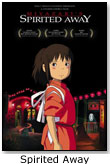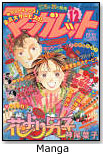
January 11, 2026


The 2003 Academy Award for Best Animated Film went to “Spirited Away,” the Hayao Miyazaki feature about a young girl’s adventures in a fantasy world. The win bolstered the popularity of a phenomenon already embraced in the United States. Enthusiasm for anime and all things related isn´t going to subside anytime soon. 
Opinions differ as to what breakthrough property ignited the anime explosion in the U.S. “Pokemon,” the late 1990s television show, started a craze extending to trading cards, video games, clothing and accessories. It “opened the flood gates and introduced the category,” says John Easum, senior vice president and executive producer for ShoPro Entertainment, San Francisco, CA. “At that time there were only a handful of Japanese animated shows on major children’s TV networks, including ‘Dragon Ball Z,’ and ‘Sailor Moon.’”
Jennifer Diane Reitz, creator of Otakuworld, part of Otakuworld.com, which preserves and promotes anime and manga, argues that Harmony Gold’s “Robotech,” a multi-generational television series preceding “Pokemon,” was “the single biggest mainstream breakthrough of anime into North America .” The sci-fi anime show included 85 episodes and first aired in 1985. Nineteen years later, comics, toys and videos contunue to sell in the US under the Robotech banner.
Even earlier were the anime shows of the 1960s, including the classic “Astro Boy,” and “Tetsuwan Atom,” “Speed Racer,” and “Mach Go Go Go.” “Hakujaden,” a 1958 fantasy film by the Japanese animation giant TOEI is considered by some to have started modern Japanese animation. It was released in North America as “Panda and the Magic Serpent” in 1961.
The Roots of Anime: Manga
 Richard Llewellyn, physical science librarian at Iowa State University in Ames, IA, has compiled a comprehensive online animation chronology. He observed that anime grew out of the manga tradition. “Japan has a rich artistic heritage that includes narrative visual art,” says Llewellyn. Manga, typically understood to be Japanese comics, today fills bookstore shelves with pocket-sized, 200-page squarebound volumes.
Richard Llewellyn, physical science librarian at Iowa State University in Ames, IA, has compiled a comprehensive online animation chronology. He observed that anime grew out of the manga tradition. “Japan has a rich artistic heritage that includes narrative visual art,” says Llewellyn. Manga, typically understood to be Japanese comics, today fills bookstore shelves with pocket-sized, 200-page squarebound volumes.
Not to be confused with American comic books, these popular works are read back-to-front and are considered literature, rather than kid stuff, in Japan.
“Anime and manga content can range from the very childish to the very adult, from romances to horror stories, from westerns to science fiction, from historical drama to sports reporting. Manga and anime are even used for instructional manuals and classroom education as well as business and industrial applications,” says Reitz.
The Business of Anime
“Compelling themes, rich characters, and a proven track record in manga are the cornerstones of successful animation,” says Easum, with the best of the crop earmarked for television development. Viewers find anime shows on the Cartoon Network, Tech TV, Kids’WB!, Fox Box, and JETIX (a branded programming block on Disney´s ABC Family Channel). Fans also purchase DVDs and videos of old and current series.
In addition to DVDs and videos, the internet and other technological advances have provided additional venues for anime fans. Brian Grimwood is head of press and publicity for Otakon 2004, one of the many conventions held to celebrate Japanese animation, manga, J-pop, and East Asian culture. He says internet anime communities have existed almost as long as internet communication has been available. He adds that these communities include groups that subtitle Japanese anime not licensed here and "release" it via peer-to-peer networks, a clandestine process which has nonetheless served to increase the fan base.
The Anime influence now spills over to nearly every aspect of daily life. Licensing deals involving anime are pervasive among for retailers and manufacturers.
Viewers buy DVDs to enjoy their favorite movies and series anytime they want, and they play CDs with anime songs, and eat Japanese snacks with anime packaging. Gamers enjoy role playing video games that extend the animated world by involving the player in the adventure or fantasy and often use strategy guides as they play. Internet surfers visit sites to read anime and read about anime. Wallpapers, pictures, toys, calendars, bags, backpacks, banks, stickers, and other accessories provide reminders of favorite characters or stories. Even advertising, such as a recent campaign for Benihana, involves anime.
According to ICv2.com, which reports on pop culture products, a few of the 2004 anime “hot properties” include:
Anime continues to bring new characters, new stories, and new perspectives to fans worldwide, winning viewers in North America and Europe at an unprecidented rate.
TDmonthly Magazine Upcoming Articles:
For Fans, Anime is a Way of Life
Anime fans aren’t just watching the latest cartoons or reading up on their favorite characters – they’re living a lifestyle. ...READ MORE ![]() Beyond the Cartoon: Top Anime Products
Beyond the Cartoon: Top Anime Products![]() Anime Goes West
Anime Goes West
Copyright © 2026 TDmonthly®, a division of TOYDIRECTORY.com®,
Inc.